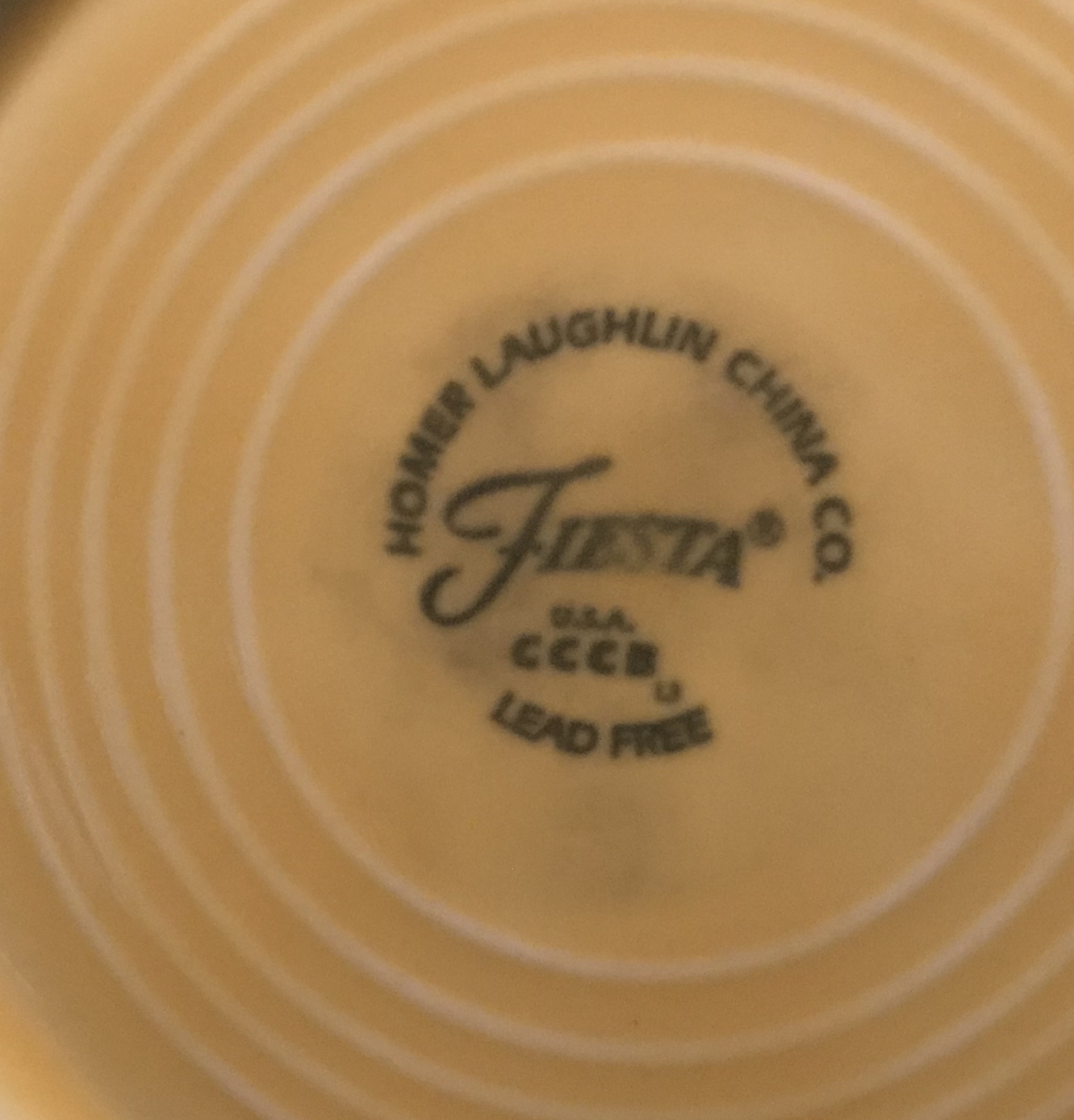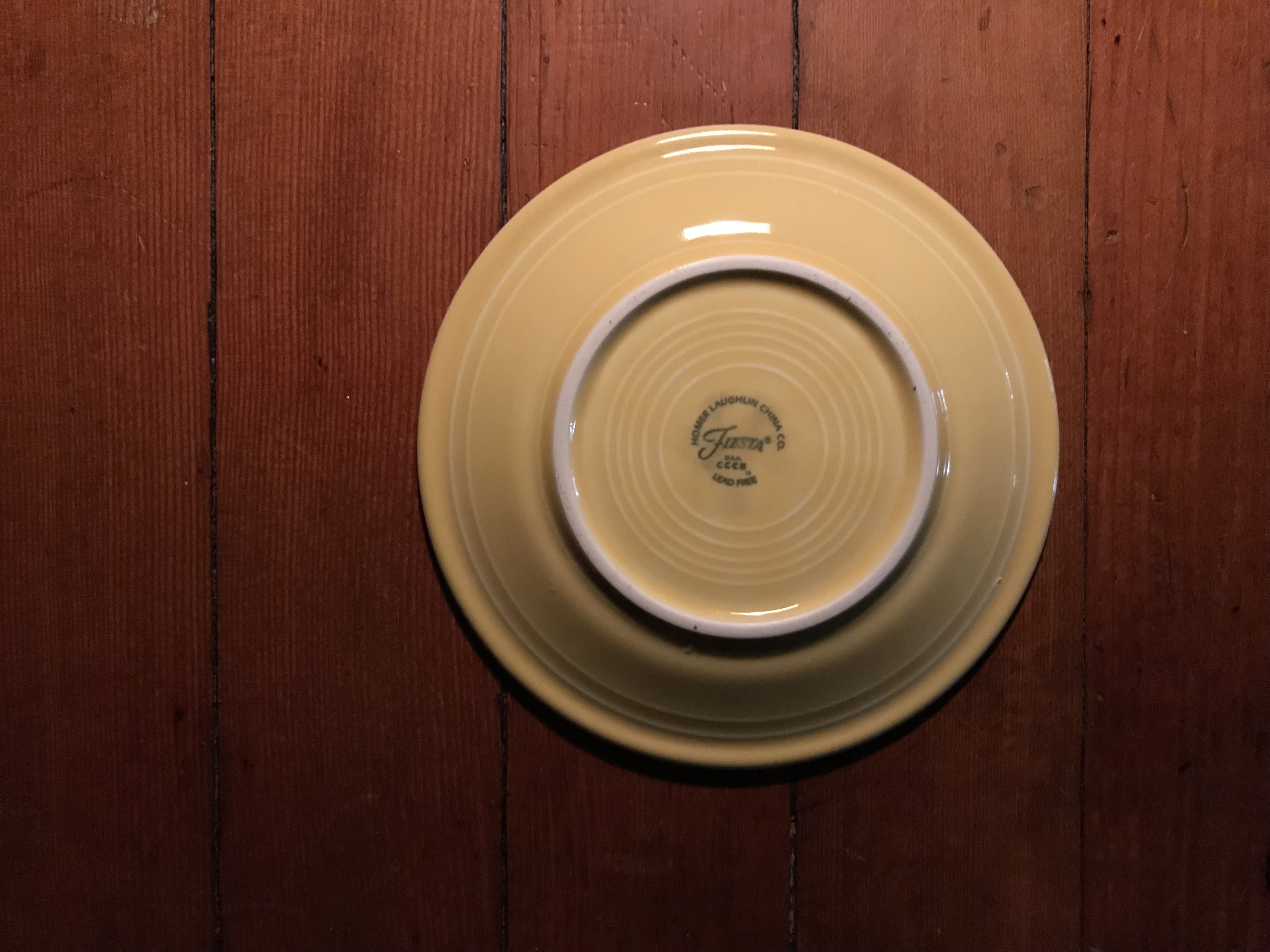Modern Fiesta Homer Laughlin China Small Dish. Marked “Lead Free”. Negative for Lead, Cadmium, Mercury & Arsenic!
When tested with an XRF instrument this small modern yellow Fiestaware plate had the following readings:
- Barium (Ba): 697 +/- 82 ppm
- Zinc (Zn): 13,200 +/- 400 ppm
- Copper (Cu): 320 +/- 60 ppm
- Iron (Fe): 999 +/- 196 ppm
- Vanadium (V): 1,150 +/- 85 ppm
- Titanium (Ti): 2,010 +/- 139 ppm
- Zirconium (Zr): 16,200 +/- 500 ppm
The dish was negative (non-detect) for Lead, Mercury, Arsenic, Cadmium and Antimony! #TruthInAdvertising!
Metals not listed were not detected by the XRF. Tests were done in consumer goods mode for a minimum of 60 seconds. Results are science-based and replicable.
Food surface and back of dish had similar levels when tested with an XRF instrument.
Note: Not all of the new Fiesta pieces (marked “Lead Free”) that I have tested have, in fact, been 100% Lead-free. Some have tested positive for very low levels of Lead (generally well below 90 ppm.) Some colors of the “Lead Free” Fiestaware have also tested positive for low levels of Cadmium and Arsenic (as well as other metals.)
To see more Fiesta pieces I have tested, click here.
Thank you for reading and for sharing my posts.
As always, please let me know if you have any questions.
Tamara Rubin
#LeadSafeMama
Never Miss an Important Article Again!
Join our Email List






Thanks for testing Fiestaware. I’ve switched to using it for about 8 years now because of concerns over lead and other toxic metals. I had *hoped* that they were honest about the levels. I have the scarlet color, though, not yellow. Keep up the great work, Tamara! 🙂 For those who care, here’s what Fiesta has to say about it: https://fiestafactorydirect.com/pages/faq-dinnerware
My local tv channel did a report on lead dishes many years ago. I discussed it with my dad and we both found it very concerning. The last Christmas present he gave me before he died was 12 modern sets of 12 Fiesta dishes. I think about him every day as I do my dishes; it’s a nice reminder of how much he loved us.
ok so I keep reading that Fiestaware is lead free and the glaze is cadmium free. So what about Arsenic free?
Is this a given?
What years are considered “Modern” on the Fiestaware?
Anything made after 1986 is modern Fiestaware, with virtually no lead in it.
Pieces 1973 and earlier are a big no-no. Though, of course, you can still use vintage pieces you won’t eat directly off of. I see no reason for instance, you couldn’t put a doily on an old Fiestaware platter and put some cupcakes in their wrappers safely on top of it for a party. Not much risk in that. Nor can I see any reason that you would worry about using an old Fiestaware vase, unless you plan on eating the flowers afterwards. Nor a Fiestaware ash tray, (of course if you smoke already, lead may be the least of your concerns health-wise!)
There’s no hard-and-fast rule to differentiate the vintage vs. the modern, but these tips can help you identify new or old Fiestaware:
Modern pieces like plates are often stamped, with a plain black stamp. If they’re stamped, you can be sure they are modern and lead-free, and the newest pieces will literally read ‘Lead-Free’ on them. Some marks are embossed in the piece in a ‘hand-written’ style. Oftentimes, they can be differentiated by the ‘F’ in Fiestaware. Older Fiestaware used a lowercase f, whereas the new stuff uses an uppercase ‘F’ in the ‘hand-signed’ pieces.
The colors can reveal if they are modern or vintage. 95% of the time, you can also easily tell by the color. Very few modern pieces match the older colors exactly. There are a couple exceptions, for example, modern Turquoise is a particularly hard color since it closely matches its vintage color; It is easy for someone with an untrained eye to make that mistake.
The styles can reveal too if they’re modern or not; For example, the modern sugar bowls are more simplistic and made to match the salt and pepper shakers already on your table. The modern teacups have no Art Deco styling at the handle. The ‘Tom & Jerry’ mugs are the opposite; They have more flare at the top in the modern version and are nicer than the vintage versions, in my view.
Also, modern Fiestaware will often have ‘dry feet’ meaning a small area not glazed at the bottom where the pottery sat when the glaze was applied. Older Fiestaware will often be completely glazed; again, not all, but most. I owned a vintage sugar bowl with dry feet that was definitely lead-glaze.
This guide here will make everything 100% clear. It has photos to help you identify the vintage stuff. It is important to note that you are more than likely to find the modern stuff at flea-markets, Craigslist, and yard sales. The newer stuff is extremely commonplace now, having been back on the market for over 35 years, and the older pieces often show up on eBay where they fetch a higher dollar, rather than an in-person transaction. (Hopefully those people on eBay know not to use them for eating!!!)
https://estatesales.org/thegoods/the-complete-guide-to-fiesta-ceramics
Hope this helps!
Hello Tamara, I have just recently purchased some fiesta dishes from Wayfair and Everything Kitchens. I want to make sure everything is modern to limit lead exposure etc. None of it says lead free. I bought bistro 3 piece serving sets with salad and dinner plates in Mulberry, White, Turquoise and Lapis, and 8 flared mugs in these colors as they shared with me that these colors do not have cadmium in the glazes. I also bought 6 68 oz bistro bowls in mulberry, lapis and turquoise, a sauce boat in turquoise, and two medium platters in lapis and mulberry. The majority of the embossed stamps say Fiesta HLC USA, and the platters look like fiesta r with two lines and usa at the bottom. The gravy boat says hlc fiesta with an elongated f and made in the usa. Should I be wary of any of these pieces? The sets at my local bed bath and beyond have stamped lead free serving sets.